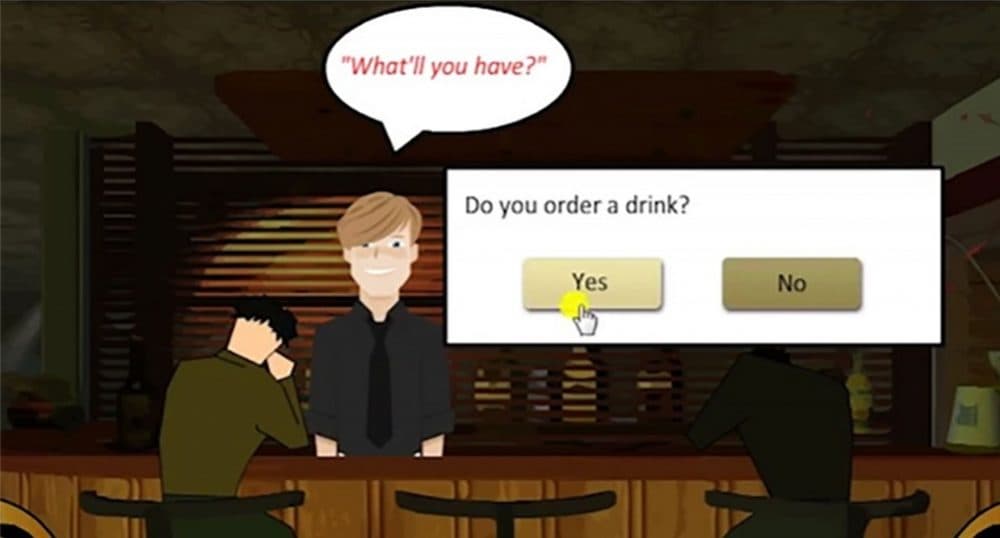Advertisement
Want To Prevent HIV Among Young Gay And Bisexual Men? Try Turning Sex Ed Into A Game

As you walk into the virtual gay bar, a handsome animated bartender greets you with a smile. A textbox, “Do you order a drink?” pops up on your computer screen.
Sure, why not? You click yes, and a martini glass icon is added to your in-game drink tally. Immediately, a new pop-up appears, reminding you to plan condom use before drinking. Noted. Time to keep exploring the bar.
To some, this interactive game may seem simple, even mundane. But for young gay and bisexual men — who are 44 times more likely to be diagnosed with HIV than American men in general — this new media experiment in prevention of sexually transmitted infections not only resonates, it actually seems to work. Really well.
A randomized controlled trial with more than 900 young gay and bisexual men compared an online HIV prevention program featuring games, candid street interviews and scripted soap operas to a control — static sex ed materials. After one year, there were 40 percent fewer cases of gonorrhea and chlamydia infection among those given the games and soaps.
The multimedia program, called "Keep It Up!," was created by researchers at the Northwestern University Feinberg School of Medicine. It's the first entirely online HIV prevention program to show a biologically relevant outcome — reduction in sexually transmitted infections. The trial results were published this week in the American Journal of Preventive Medicine.
“We were expecting maybe we would see a 10 to 15 percent reduction,” says Brian Mustanski, director of Northwestern’s Institute for Sexual and Gender Minority Health and Wellbeing and lead author of the study. “We were really, really pleasantly surprised."
"Keep It Up!" is made up of seven modules and then two “booster” sessions, completed three and six months after the initial program. The three sessions take a total of two hours to complete. The content covers everything from meeting men on hookup apps and relationship power dynamics to pre-exposure prophylaxis and substance use during sex.
All program media featured a diverse cast of characters that reflected the trial’s urban enrollees, who were recruited from Atlanta, Chicago and New York City. Nearly two-thirds (63 percent) of participants belonged to racial or ethnic minorities.
When Mustanksi and his team began designing "Keep It Up!," they wanted to make sure it was not only accurate, but relevant. “We started [by] doing qualitative interviews with diverse young men,” he says. They queried 18- to 29-year-old gay and bisexual men in major metropolitan areas about where they sought out sexual health information and what they wanted know about HIV.
The interview results were resoundingly clear: Available resources were too academic and removed from reality. Those interviewed “really wanted to understand how [HIV prevention] fit into their lives,” Mustanski says. “They didn’t want … it [to] feel like it was a class, you know?”
The prep work seemed to have paid off; participants gave "Keep It Up!" rave reviews, including this one:
I like how things are explicit and get straight to the point. Things seemed ‘real’ and things weren't ‘hush hush’ (drug use and alcohol use). I liked relearning things so I can be reminded that anything can happen to anyone.
Mustanski hopes "Keep It Up!" will one day be available nationally. He is currently seeking funding to test the program across the U.S. “There’s no point in doing it if it’s just going to sit on the shelf,” he says.
You may be wondering: Why were chlamydia and gonorrhea used to measure the effectiveness of an HIV prevention program? Mustanski says there are a number of reasons. For one, the relative rarity of HIV infection means one would need “an enormous trial to detect an effect,” making HIV an infeasible measure for the size and time of the study.
Also, because these two infections “biologically increase your risk of getting HIV,” he says, they are useful markers to assess risky sexual behavior. The study also measured acts of condomless anal sex, which fell slightly more among "Keep It Up!" participants.
Finally, chlamydia and gonorrhea can both be tested for with simple swabbing, unlike syphilis, which requires a blood test, so participants could discreetly complete follow-up testing for the trial at home and return their samples by mail.
Researchers were careful to include racial and ethnic minorities in the trials, because they are disproportionately impacted by HIV. While the overall risk of HIV infection is on the decline nationally, breaking down data by ethnicity and race paints a grimmer picture. According to current projections, 1 in 4 Latino men who have sex with men are projected to become HIV positive in their lifetimes — as well as half of all black men who have sex with men.
“Far too many young gay and bisexual men of color are still not benefiting from quality HIV prevention and care,” writes Dr. William L. Jeffries IV, associate chief for science for the CDC’s Division of HIV/AIDS Prevention.
In a statement to WBUR, he says the CDC backs “a High-Impact Prevention strategy” for HIV, which “prioritizes cost-effective, evidence-based, and scalable interventions.
“This includes substantial efforts to reach gay and bisexual men of color with HIV testing, linkage to care, referral and education about PrEP," — pre-exposure prophylaxis — "and other critical prevention services,” he says.
Both Jeffries and Mustanski noted that, even in the age of PrEP, condoms are still an important prevention tool.